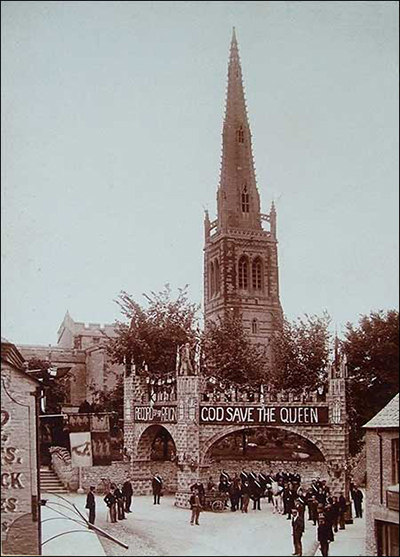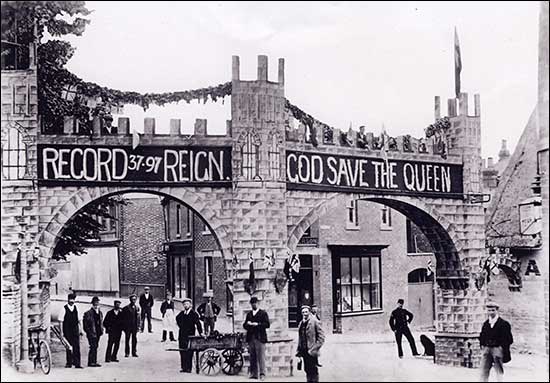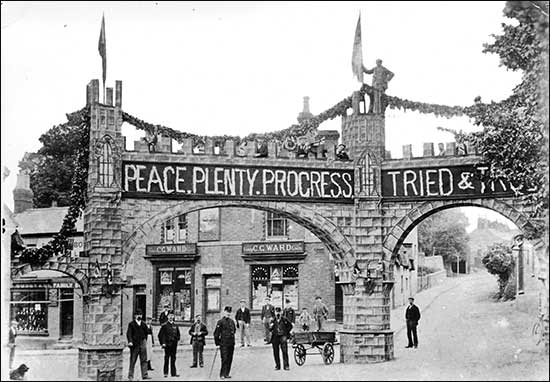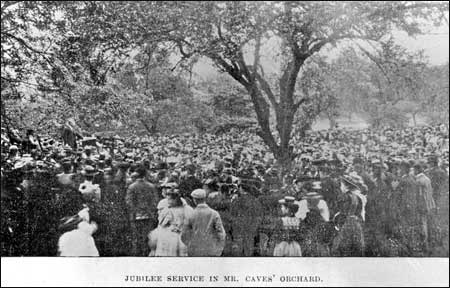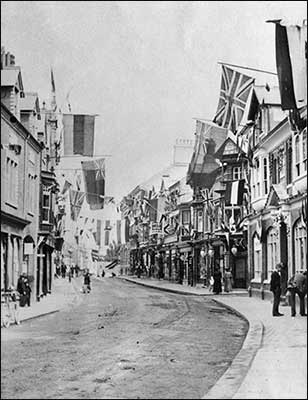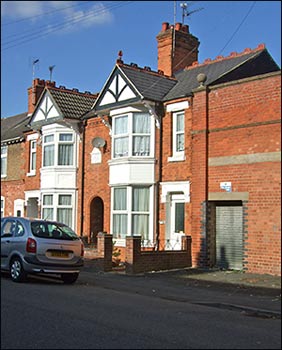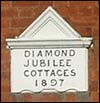|
|||||||||
| From an unidentified newsclip, probably The Argus |
|||||||||
|
1897 Queen Victoria's Diamond Jubilee
|
|||||||||
|
|
|||||||||
Rushden has never looked so gay as it did on the great Jubilee day. The request of the genial chairman of the Urban Council that the inhabitants should decorate their premises was widely responded to, and in the High-street more especially, a perfect transformation scene was effected. Gay colours floated in all directions and in the evening a flow of light burst upon the street from illuminations of the most brilliant character. In noticing the various decorations a few words must be said about the really beautiful double arch erected by the town's committee at the top of the High-street and Newton-road. A more suitable spot for the arch could not be found, and since it has been erected many have expressed the wish that the structure or a similar one could remain there. The arch, which was designed by Messrs. Preston and Wilson, is somewhat after the style of an old castle gateway. The woodwork was covered with canvas and the latter was cleverly painted by Mr. A. T. Nichols to resemble ancient stone work. Across the top were hung festoons of evergreen, relieved with bunting and flags, and suitable mottoes —white letter on a red background—were placed on each side of the arch. The portion of the arch directly facing High-street bore on its north side the wish echoed and re-echoed by many millions during the past week, "God save the Queen," whilst on the south side three characteristics of the Queen's reign appeared in the words "Peace, plenty, progress." The other portion of the arch bore on the Newton-road side the words "Record—37-97—Reign," and facing the south end of the town were the words "Tried and true." Throughout the width of the whole arch on either side gas illuminations were arranged, and when lit up the arch presented a most picturesque appearance. Small bark shields were also fixed on the sides of the pillars and grouped with flags. These latter, together with the evergreens and flags, were supplied by Mr. Seckington. Another arch, though not of so elaborate a character was erected at the entrance to the Home Close. The wood work in this instance was draped with the national colours, the red, white and blue, the top being festooned with evergreens and illuminated with gas. Across the top was the appropriate word "Welcome." Gas illuminations were also arranged direct over the gateway. |
|||||||||
| Turning to the private decorations one scarcely knows where to begin. In the High-street from the "Rose and Crown" to the Arch, very few houses were without decorations, whilst in other parts of the town there were individual decorations of an exceedingly pretty character. Neither time or expense was shared by Mr. J. W. Ashdowne in decorating the premises of the Northants Union Bank. A large star lit with gas occupied the centre of the building, and three rows of fairy lamps, red, white, and blue respectively, were hung along the whole width of the premises. The Union Jack floated from the top of the building, and other large flags were hung from the windows. On the opposite side of the road Mr. Webb had bedecked his premises in a very beautiful manner, which for good taste and neatness were scarcely excelled in the town. A large window box was fitted across the whole width of the premises, and this was prettily arranged with palms and creeping geraniums. The recesses of the upper windows were also treated in the same manner. Fairy lamps, with the colours cleverly blended, were hung around the side of each window, on a red background, and a pretty effect was produced by lamps being hung on parts of the large palms. Across the large window box was the inscription "God bless our Queen," in white letters on a red background. Numerous flags were also displayed. The most brilliantly illuminated building in the town was probably Messrs. Cave's large factory. In the centre of the building a huge device had been erected, somewhat after the style of two wings, with the words "Progress" and "Civilisation." When lit with gas it flooded the whole street with a blaze of light. On the rivetters' shop were other gas illuminations in the shape of a crown, flanked on either side by the letters V. and R. Across the entrance to the factory was the inscription "God Save the Queen." The large factory of Mr. Denton on the other side of the road was also tastefully decorated. With such a tremendous frontage it was difficult to produce a good effect with fairy lamps, but the difficulty was overcome and some hundreds of lamps hung the whole width of the building. The lamps were arranged in the form of a huge oblong, with a crown and the letters V.R. in the centre. Shields with groups of flags were also fixed on the walls and numerous flags hung from the windows. The office of the "Argus," although in the midst of such brilliant neighbours, was able to hold its own. Flanking the large bay window on the first floor on either side were the letters V.R. in evergreens, whilst the windows and the woodwork of the shop were outlined with coloured lamps. Festoons of evergreens were also displayed. | |||||||||
|
|||||||||
The front of the Coffee Tavern was also treated with numerous fairy lamps, surmounted with the letters V.R. and a crown. The windows were decorated with bunting and numerous flags were also displayed. Mr. Beddall's shop was decorated with a number of flags and bunting, whilst Mr. Smith evidenced his loyalty by displaying a photo of Her Majesty, surrounded by a number of flags. The premises of Mr. Miller were also brilliantly illuminated. The letters V. and R. in fairy lamps ware arranged on either side of the building, whilst a massive crown filled the recess over the shop front. The colours were tastefully blended, and presented a very picturesque appearance. A number of fairy lamps were also arranged across the front of Mr. Knight's shop, and the tree in front of the Vestry Hall was illuminated with similar lights. Mr. Tall's premises bore the inscription "God bless our Queen," with the letters V.R, in ivy. Proceeding towards the Home Close the premises of Messrs. Lilley and Skinner next attract attention. Whilst assisting others Mr. Newton took care that his own premises should be second to none and although amongst so many splendid decorations it would be invidious to describe any as the best Mr. Newton is to be congratulated on the picturesque manner in which he decorated the large warehouse. Across the wall facing the Green was the inscription "God Save the Queen" entirely arranged with fairy lamps. And not only so, but the letters followed each other in succession in red, white, and blue, producing, when lit up, an exceedingly pretty effect. At the corner of the building facing the street was also a large star arranged in like manner, whilst numerous Chinese lanterns added beauty to the scene. The whole of the windows were also outlined with coloured lamps, whilst flags and bunting completed the picture. A large picture of the Queen, which was illuminated during the evening, formed one of the most interesting features of Messrs. Claridge's decorations. This was flanked on either side by the initials V.R. lit up with gas, whilst a large crown composed of multi-coloured fairy lamps was arranged on the end of the factory fronting the lawn. The house and front garden were also effectively treated with fairy lamps, whilst numerous flags floated in the breeze. Fairy lamps formed the chief part of the decorations at Mr. W. Colson's house. The inevitable V.R. with the crown in the centre, were arranged across the front of the building, whilst the windows were also outlined with coloured lights. There were a few decorations in Church-street, flags being displayed by Mr. Clipson and Mr. Darnell, whilst a number of fairy lamps were arranged across the premises of the Rushden Cross Cycle Co. Mr. Woodward also displayed a representation of the Prince of Wales' crest with a number of flags. Returning to High-street South the "Wheatsheaf" first demands attention, fairy lamps being arranged across the building with the ubiquitous initials V. R. A small cottage adjacent bore the legend "All hail Victoria, 1897," whilst across the road Mr. G. H. Skinner's premises were also illuminated with a crown flanked with the initials V.R., all arranged in fairy lamps. The entrance to the Hall grounds was tastefully treated with fairy lamps and flags, and Mrs. Ballard's little shop was elaborately decorated with evergreens, flags, and bunting, with a representation of the feathers of the Prince of Wales. At this end of the town, however, the Conservative Club had no rival. Without following out any special design the walls and windows were hung with fairy lamps, but the colours were so beautifully blended that when lit up the effect was most pleasing. Bunting with photos of Her Majesty was also arranged on the walls, and with several large flags completed a most effective picture. |
|||||||||
Returning to the other end of the High-street one of the most effective illuminations was that of Messrs. Simpson and Mason's offices. Three rows of fairy lamps were arranged in a curved position on the walls on either side of the door, and shields bearing the crest of the Prince of Wales with groups of flags were also dotted about the walls. The tree inside the gate was hung with fairy lamps, and when lit up these produced a charming effect. Numerous flags were also displayed from the windows. Mr. Wilmot’s shop bore the inscription "God save the Queen,” and the “Rose and Crown” was elaborately treated with bunting and a photo of the Queen. The front shop of Mr. Ashby's premises looked exceedingly pretty with fairy lamps arranged around the windows and across the top of the shop. The Union Jack also floated from the top of the building. The "Feathers" and Mr. Staniland's premises displayed fairy lamps, whilst from Mr. Seckington's windows floated the Union Jack and Civil Service flag. Across the top of the shop were the letters V. R. surmounted with a crown tastefully arranged with fairy lamps, the premises making altogether a very attractive display. Mr. Ellis displayed a representation of a statue of the Queen, underneath being the figures 1837-1897—not out 60, together with numerous flags. The Capital and Counties Bank was treated with fairy lamps, the initials V. R. and a crown being arranged in the centre of the building. A number of Chinese lanterns were suspended from Messrs. J. and C. Robinson's premises, and Messrs. Hockney's large shop front was also effectively treated with art muslin, bunting, and Chinese lanterns, together with a number of flags. The block of buildings comprising Messrs. Stimpson's, Tisinbom's, and Powell's premises were also tastefully decorated. On the front of Mr. Stimpson's shop was a photo of the Queen surrounded by a trophy combining the five Union Jacks, whilst a similar trophy was placed in like manner over Mr. Powell's premises. Art muslin was arranged across the balustrade at the top of the shop, and fairy lamps were suspended from the woodwork. |
|||||||||
There were many other minor decorations too numerous to mention. Lines of streamers spanned several of the streets, and flags were displayed at numberless private houses. The gas illuminations were lit on Monday, Tuesday, and Wednesday evenings, whilst the whole of the lamps were lit both Tuesday and Wednesday. The opinion expressed on all sides was that the illuminations and decorations surpassed anything ever dreamt of, and everyone will feel a pang of regret when the town resumes its normal state. |
|||||||||
|
|||||||||
|
|
|||||||||
